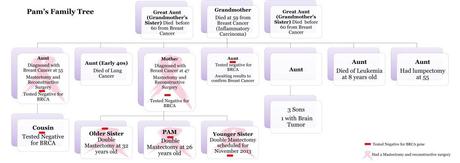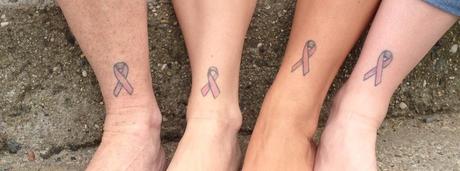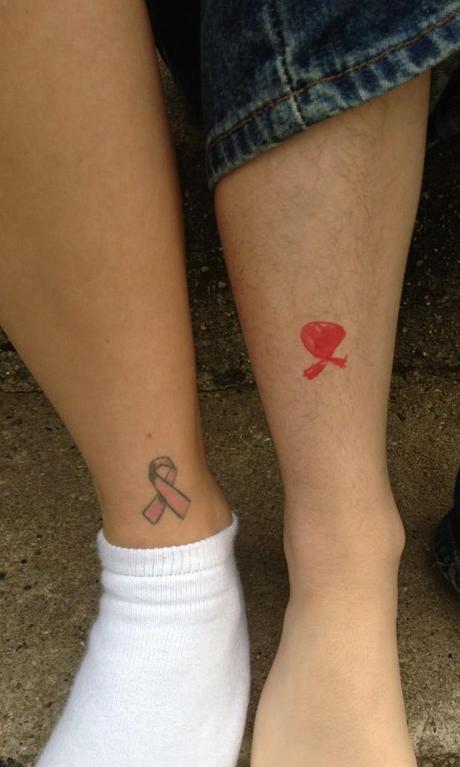Pam shared her story with me and I was astonished on so many levels. The family history, the battle with insurance companies, the choices she made, her story is quite unique. We began our conversation, chatting for a few minutes about MKB and the breast cancer awareness features and the best way to tell her story. She is currently recovering from her second reconstructive surgery post her mastectomy. The mastectomy she had when she was 26 years old. The second reconstructive surgery she was recovering from at 29 years old. The fact that she DID NOT have breast cancer, I was surprised but when she went on to tell her story, you completely understand why she would take these preventive measures.
Pam’s Story:
Pam’s Grandmother died at 59 years old of inflammatory carcinoma. Her grandmother along with her great aunts were all victims of breast cancer, dying before they reached 60 years of age. 11 women in 2 generations of her family have had breast cancer. Pam’s Mother was diagnosed with breast cancer at 47. She is the first woman in their family to survive! Her survival was the impetus for the other women in the family to vigorously and conscientiously fight back against cancer.
There has been a great deal of mention of the genetic tests that check for BRCA1 and BRCA2 mutations in people with a family history of cancer that suggests the possible presence of a harmful mutation in one of these genes. Because of their family history, Pam and her two sisters, one older, one younger attempted to be tested for the gene. Sadly their attempts were defeated by the insurance company. The insurance company declared they were not eligible to be tested because their Mother, who was battling cancer at the time, had tested negative for the gene. They were told any mammograms or genetic testing would not be covered because they were too young and there was no imminent danger regardless of the family history.

Click the picture to see the family history.
Realizing this was indeed a special case, the doctors and staff at Staten Island University Hospital North fought on their behalf. They insisted the sisters receive mammograms and the proper screening. Her first mammogram found a significant amount of abnormal cells. Pam decided she would take the aggressive approach and have a double mastectomy. Her mastectomy was scheduled for June 2011.
On March 13, 2011, Pam underwent a test that involved 10 needles inserted into each nipple, using iodine to highlight the abnormal cells. Two abnormal areas were detected. In June when she returned and had the same test, 3 abnormal areas were found in her left breast and 6 in her right breast. In just four months, Pam’s cells were rapidly changing. Choosing to have the mastectomy and reconstructive surgery done at the same time, Pam was in surgery for 14 hours. Almost 2 years later, she elected to have another reconstructive surgery to repair breast tissue and eliminate pain she was experiencing from the first surgery. In choosing to remove her breasts, she opted to keep her nipples, which means she still has to monitor her cell development and have tests regularly.
With the results of last test in June, it was clear her decision to completely remove her breast tissue with the double mastectomy was not only a life changing decision but certainly a life saving decision. A decision that she and her sisters have all made to make sure their risks of cancer are significantly reduced.

The day her mother received her diagnosis, Pam took her mom and older sister to get Breast Cancer Awareness bow tattoos to show a united front. Her younger sister was pregnant at the time but got her tattoo later.

Pam’s son wanted a tattoo like his Mom, Aunts and Grandmother so he drew his own to show support!
The new genetic tests for BRCA are helping the fight against cancer but it is important to note that Pam, her mother and all of her relatives have all tested negative for this gene. While it is an improvement and a major breakthrough for these tests to exist and be administered, it is extremely important to note, a negative test does not mean you are in the clear.
The notion that breast cancer is an older woman’s disease must be discarded. This disease does not discriminate! It is important that women (and men) of all ages do regular self exams. If you feel something different, talk to your doctor. Insist on having a mammogram, regardless of your age. In Pam’s case, she was 26 years old and her cells were rapidly changing, suggesting a possible future cancer diagnosis. Because of her relentless approach to testing and screenings, she has most definitely reduced her risks and serves as a cautionary tale for all of us. If you believe you should push further and receive more medical care and attention than your doctor may suggest, don’t accept no, continue pushing until you are satisfied, your life may depend on it.
Another important piece of Pam’s story is the knowledge of her family history and the role it played in her decision-making. Do your research, learn about the health of your family members. This will greatly aid in how you can prepare and monitor your health care.
Thank you Pam for sharing your story with us. You and the women in your family are truly brave and inspiring people. Your choice to share your experience and help to continue to spread and increase awareness is very much appreciated.
xoxo- Kellie

